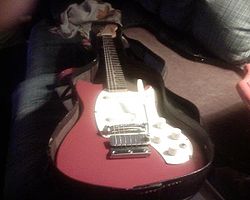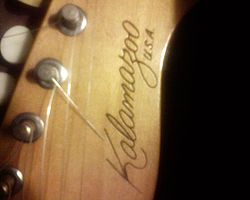
Gibson Kalamazoo Electric Guitar
Encyclopedia


Electric guitar
An electric guitar is a guitar that uses the principle of direct electromagnetic induction to convert vibrations of its metal strings into electric audio signals. The signal generated by an electric guitar is too weak to drive a loudspeaker, so it is amplified before sending it to a loudspeaker...
produced by Gibson
Gibson Guitar Corporation
The Gibson Guitar Corporation, formerly of Kalamazoo, Michigan and currently of Nashville, Tennessee, manufactures guitars and other instruments which sell under a variety of brand names...
during the 1960s
1960s
The 1960s was the decade that started on January 1, 1960, and ended on December 31, 1969. It was the seventh decade of the 20th century.The 1960s term also refers to an era more often called The Sixties, denoting the complex of inter-related cultural and political trends across the globe...
and 1970s
1970s
File:1970s decade montage.png|From left, clockwise: US President Richard Nixon doing the V for Victory sign after his resignation from office after the Watergate scandal in 1974; Refugees aboard a US naval boat after the Fall of Saigon, leading to the end of the Vietnam War in 1975; The 1973 oil...
under Gibson's parent company Chicago Musical Instruments. A budget model, it had a body that was made of Medium-Density Fiberboard
Medium-density fibreboard
Medium-density fiberboard is an engineered wood product formed by breaking down hardwood or softwood residuals into wood fibres, often in a defibrator, combining it with wax and a resin binder, and forming panels by applying high temperature and pressure...
(MDF) and inexpensive components.
The Kalamazoo
There were two prominent designs. The first, made from 1965 to 1968, was reminiscent of the Fender MustangFender Mustang
The Fender Mustang is an electric guitar by the Fender Musical Instruments Corporation, introduced in 1964 as the basis of a major redesign of Fender's student models then consisting of the Musicmaster and Duo-Sonic. It was produced until 1982 and reissued in 1990.In the 1960s, it was used in Surf...
; the other, made from 1968 to the early 1970s, bore more resemblance to the Gibson SG
Gibson SG
At the launch of the SG in 1961, Gibson offered four variants of the SG; the SG Junior , the SG Special, the SG Standard, and the top-of-the-line SG Custom. However, Gibson's current core variants as of 2010 are the SG Standard and the SG Special...
. The headstock bore a "Kalamazoo USA" logo rather than Gibson's usual decal. A variety of configurations and pickup options were available, including a vibrola tremolo
Tremolo arm
A whammy bar, tremolo arm/bar, or vibrato arm/bar is a component of a guitar, used to add vibrato to the sound by changing the tension of the strings, typically at the bridge or tailpiece...
system, and single coil
Single coil
A single coil pickup is a type of magnetic transducer, or pickup, for the electric guitar and the electric bass. It electromagnetically converts the vibration of the strings to an electric signal...
"melody maker" pickups
Pickup (music technology)
A pickup device is a transducer that captures mechanical vibrations, usually from suitably equipped stringed instruments such as the electric guitar, electric bass guitar, Chapman Stick, or electric violin, and converts them to an electrical signal that is amplified, recorded, or broadcast.-...
. The initial run of the Kalamazoo featured the KG-1 single-coil pickup, KG-1A single-coil pickup and vibrola, KG-2 dual single-coil pickups, and KG-2A dual single-coil pickups and vibrola. .
Gibson was sold to a different parent company, Norlin. The deal called for further restructuring and the Kalamazoo name was dropped. The Epiphone
Epiphone
The Epiphone Company is a musical instrument manufacturer founded in 1873 by Anastasios Stathopoulos. Epiphone was bought by Chicago Musical Instrument Company, which also owned Gibson Guitar Corporation, in 1957. Epiphone was Gibson's main rival in the archtop market...
name took its place as Gibson's budget line marquis, a place it holds to this day.
The Kalamazoo Bass
The Kalamazoo Bass was introduced in 1966 as a companion to the six string guitar. Like the KG, the KB was made with the two body styles resembling the Mustang and the SG. The earlier headstocks were, again, reminiscent of Fender models. Later headstocks bore a resemblance to that of the Gibson ThunderbirdGibson Thunderbird
The Gibson Thunderbird is an electric bass guitar made by Gibson.-Background and introduction:The Gibson Thunderbird was introduced in 1963. At the time, Fender had been the leader in the electric bass market since their introduction of the Precision Bass twelve years earlier.The Thunderbird was...
bass guitar. Several standard Gibson components were used in the KB, namely a typical EB series humbucker pickup used in many Epiphone
Epiphone
The Epiphone Company is a musical instrument manufacturer founded in 1873 by Anastasios Stathopoulos. Epiphone was bought by Chicago Musical Instrument Company, which also owned Gibson Guitar Corporation, in 1957. Epiphone was Gibson's main rival in the archtop market...
basses. Sales were initially good, and during 1966-67 this was by far the best selling bass made at the Gibson plant. Production of the KB ceased in 1969.
Kalamazoo Amplifiers
At the same time Gibson introduced the Kalamazoo guitar, they also began production of a line of Kalamazoo amplifiersGuitar amplifier
A guitar amplifier is an electronic amplifier designed to make the signal of an electric or acoustic guitar louder so that it will produce sound through a loudspeaker...
. They were marketed primarily as budget model practice amps to supplement the marquis. The first amp introduced, the Model One, began production in 1965 along with the guitars. It was followed in 1966 by the Model Two. Both used vacuum tubes for power, rectification, and output. Both had a 5W output and a 10" Alnico
Alnico
Alnico is an acronym referring to iron alloys which in addition to iron are composed primarily of aluminium , nickel and cobalt , hence al-ni-co, with the addition of copper, and sometimes titanium. Alnico alloys are ferromagnetic, with a high coercivity and are used to make permanent magnets...
speaker. The differences between the two were few, with one major exception. The Model 2 was equipped with a tremolo circuit tube to accompany the volume and tone controls shared with the Model 1. The Model 2 proved more popular with this extra feature. By present day standards, these models are not as desirable for use with guitars. However, they are fairly sought after by blues harmonica players for use in amplifying their sound with microphones due to their distorted "fat tone".
Around 1969, solid state versions of the Models One and Two were introduced. The Model 3 and Model 4 respectively, used transistors in place of the vacuum tubes. These models, while novel in their day, ultimately proved unpopular.
The Kalamazoo Reverb 12 was introduced as a larger, more powerful amplifier, boasting a 12W tube driven output through a 10" speaker. The Reverb 12 featured a tremolo circuit like the Model 2, but with depth control along with frequency. The tone was managed by individual bass and treble controls as opposed to the single tone control on earlier models. It also had a reverb, a feature not offered on other Kalamazoo amps.
Gibson also produced Kalamazoo bass amplifiers. The Bass 30 and Bass 50 both used a pair of 10" Jensen speakers and were tube driven. The later models of the Bass 30 were configured in an upright cabinet as opposed to the typical horizontal cabinet. The Kalamazoo Bass (with no number attached) was usually made in a solid state form, although some specimens have been found to be equipped with tubes.
External links
- Official website of Gibson USA. Accessed on January 6, 2009.
- Kalamazoo Amp Field Guide. Accessed on October 6, 2011.

